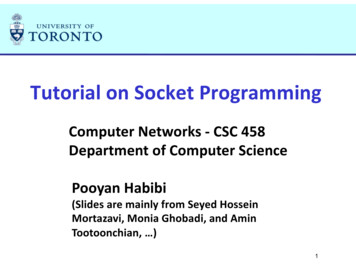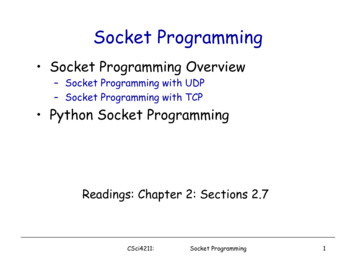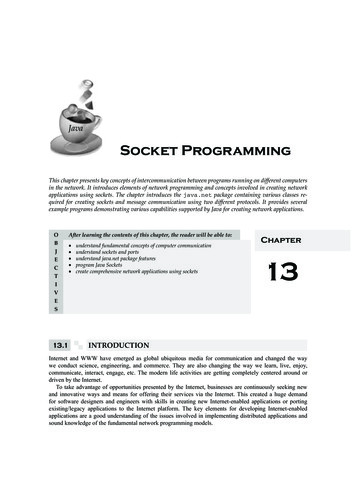
Transcription
Socket.IO Real-time WebApplication DevelopmentBuild modern real-time web applications poweredby Socket.IORohit RaiBIRMINGHAM - MUMBAI
Socket.IO Real-time Web Application DevelopmentCopyright 2013 Packt PublishingAll rights reserved. No part of this book may be reproduced, stored in a retrievalsystem, or transmitted in any form or by any means, without the prior writtenpermission of the publisher, except in the case of brief quotations embedded incritical articles or reviews.Every effort has been made in the preparation of this book to ensure the accuracyof the information presented. However, the information contained in this book issold without warranty, either express or implied. Neither the author, nor PacktPublishing, and its dealers and distributors will be held liable for any damagescaused or alleged to be caused directly or indirectly by this book.Packt Publishing has endeavored to provide trademark information about all of thecompanies and products mentioned in this book by the appropriate use of capitals.However, Packt Publishing cannot guarantee the accuracy of this information.First published: February 2013Production Reference: 1120213Published by Packt Publishing Ltd.Livery Place35 Livery StreetBirmingham B3 2PB, UK.ISBN 978-1-78216-078-6www.packtpub.comCover Image by Suresh Mogre (suresh.mogre.99@gmail.com)
CreditsAuthorRohit RaiReviewersArnout KazemierProject CoordinatorEsha ThakkerProofreaderElinor Perry SmithAndrew KeigIndexerAcquisition EditorRekha NairWilson D'souzaGraphicsCommisioning EditorValentina D'SilvaHarsha BharwaniProduction CoordinatorTechnical EditorsNilesh R. MohiteIshita MalhiDominic PereiraCopy EditorsAditya NairAlfida PaivaRuta WaghmareCover WorkNilesh R. Mohite
About the AuthorRohit Rai is an accomplished software engineering professional and entrepreneurwith several years of experience in developing products and consulting with clientson a variety of technologies, from enterprise applications on .NET and Java EE,consumer web applications focusing on JavaScript, data engineering and analyticsplatforms such as Pentaho and Hadoop, to modern platforms such as Groovy, Scala,and Node.js.He is a founder of TupleJump, a startup building a new-generation data engineeringplatform for unifying and optimizing the workflows of data scientists, engineers, andanalysts, bringing in innovative data process development approaches and modernvisualization frameworks, all built on cutting-edge technologies designed to scaletransparently from a single machine to large, distributed big data clusters.He has previously worked with Cordys R&D, Pramati technologies, and variousstartups. He has consulted with clients like Intel and Sun, helping them developproducts like Mash Maker and Zembly, powered by JavaScript. He was a memberof one of the first teams on SocialTwist and developed one of the first widgets as aservice platform and framework, which continues to power this widely-successfulsocial media marketing and referral platform used by many Fortune 500 companies.In open source, Rohit is a core committer and the administrator of Matisse(http://www.matisse.org/), the collaborative design platform. He is also thecreator of socket.io.play, the Socket.IO module for the Play framework, and variousopen source projects hosted at GitHub (https://github.com/rohit-tingendab).
AcknowledgementWriting a book, especially your first one, is an uphill and demanding task that cannotbe accomplished by a single person without support from several others, and thisbook is no different. I would like to thank everyone who has played a role in helpingme write this book or helping me reach the point where I could think of writing myown book. Though I cannot mention all the people by name, I am heartily gratefuland indebted to everyone. However, I would like to mention the people who haveplayed a directly important role in this book.First of all, I have to thank my father and his elder brother, my uncle, who together,played the most important role in my personal and academic development. Theyinscribed on my mind, the importance of learning and knowledge above all elsein life.I would like to thank my wife, Paridhi, and my brother, Rajat, for bearing with mytantrums and idiosyncrasies, and still understanding and supporting me during mylong hours of work and writing. I couldn't have pulled it off without them. The othervery important person that I need to mention is my cousin, Shiti, who was alwaysreviewing the book, giving exceptional feedback, running, debugging, and correctingthe code for me, and also taking over quite a bit of my workload and my projectswhenever she could. I have to thanks all my friends and cousins who played animportant role in my upbringing, and who understood my missing all their partiesand celebrations all the time.I have to thank my friends, partners, and founders at my two ventures, Satyaprakashat TupleJump and Guillermo at Happymer, who have unconditionally supported methrough the writing of this book and coped with me missing meetings and runningslow at work from time to time.I thank Pramati Technologies, the place where I learned most of what I know todayand spent most of my career. I thank Jay and Vijay Pullur for starting this wonderfulcompany; it is one of the very best places to work at.
I have to thank my managers, mentors, and guides at Pramati, specially RameshLoganathan, Chandrasekhar Sivaram, and KVP who have taught me a lot. All ofthem helped develop particular skill sets within me, without which I could neverhave written a book or started my own company. Chandru and KVP gave me thefreedom to choose my projects, run my teams my way, and also the support tobuild Matisse and socket.io.play. Ramesh, who was the first published author I gotto know in person, is my inspiration to write. Talking about mentors, I owe myprofessional success to Vivek Lakshman, my manager at Cordys and SocialTwist,my mentor, protector, guide, and above all, a friend I probably didn't do muchto deserve. He has always challenged me to set higher goals for myself and thensupported and pushed me to achieve these targets. The positive energy that hebrings to any conversation helps boost the morale of everyone around.My thanks go to everyone at Pramati for helping me, assisting me, and guiding mefrom time to time. I must thank my friends and colleagues, Apurba and Sunny (nowat Sprinklr), who have always challenged me to learn more, explore more, and keepimproving from time to time. Sunny was the one who forced me to dig deeper inJavaScript and functional programming during our SocialTwist days. And Apurba issomeone from whom I have learned a lot; I still feel like a student in his presence.The acknowledgements for a book on any technology would be incomplete withoutthanking the creators. I am thankful to Ryan Dahl, the creator of Node.js andGuillermo Rauch, the creator of socket.io, and the countless open source contributorsto these and other enabling technologies, without whom these projects, and in turnthis book, would have been impossible.Last but not the least, I have to thank the team of editors and reviewers for thisbook. I thank the editors at Packt, Manali, Harsha, and Esha, who have been verygood to me, understood the challenges for a first-time writer, and been consideratewith delays and shuffling of deadlines. I also thank the reviewers who have done anexcellent job of pointing out what is missing in the book, correcting the mistakes, andreviewing the code. Thank you guys, you have been great!
About the ReviewersArnout Kazemier is a Software Engineer from the Netherlands. He was originallyschooled as a multimedia designer, but quickly rolled in to the world of frontenddevelopment and started to appreciate the beauty of JavaScript. After finding out thatit was also possible to write JavaScript on the server side, he started using AptanaJaxer and Narwal in his spare time. It wasn't until much later that Arnout heard aboutNode.js and its possibilities, and decided to take it for a spin when version 0.1.3 wasreleased. Since then, he has never looked back. When Arnout joined the first Node.jshackatron (Node Knockout 2010), he built a real-time heat mapping engine on Node.js using Socket.IO. During the programming contest he learned a lot about Socket.IO and solved tons of issues that he encountered during the development of hisentry. When the contest ended, he didn't stop contributing to Socket.IO, eventuallybecoming the first core team member of Socket.IO. He has been talking at differenttech conferences since. Fast forwarding to 2013, he now spends time working onhis own startup website http://observe.it (it won Node Knockout 2011) whichallows you to observe and learn from your user's behavior in real time. He's stillactively involved with the development of Socket.IO and conducts research on theconnectivity of the real-time web and the impact of firewalls & virus scanners.Andrew Keig has been building cutting-edge web applications for over 12years. Andrew is a director at airasoul.net, which he runs with his artistwife Rima. Airasoul specializes in the design and build of scalable, RESTful,specification-driven, real-time web and mobile-based applications on both theNode.js and .NET stacks.Andrew has a degree in Computing, and blogs at blog.airasoul.net on topicshe is passionate about, such as Node.js, REST, Web APIs and Behavior-DrivenDevelopment. Andrew contributes to various open source projects for Node.jsand .NET.Andrew lives in London with his family: wife Rima and his son and inspiration, Indie.
www.PacktPub.comSupport files, eBooks, discount offersand moreYou might want to visit www.PacktPub.com for support files and downloads related toyour book.Did you know that Packt offers eBook versions of every book published, with PDF and ePubfiles available? You can upgrade to the eBook version at www.PacktPub.com and as a printbook customer, you are entitled to a discount on the eBook copy. Get in touch with us atservice@packtpub.com for more details.At www.PacktPub.com, you can also read a collection of free technical articles, sign up for arange of free newsletters and receive exclusive discounts and offers on Packt books and eBooks.TMhttp://PacktLib.PacktPub.comDo you need instant solutions to your IT questions? PacktLib is Packt's online digital booklibrary. Here, you can access, read and search across Packt's entire library of books.Why Subscribe? Fully searchable across every book published by Packt Copy and paste, print and bookmark content On demand and accessible via web browserFree Access for Packt account holdersIf you have an account with Packt at www.PacktPub.com, you can use this to access PacktLibtoday and view nine entirely free books. Simply use your login credentials for immediate access.
Table of ContentsPrefaceChapter 1: Going Real Time on the WebWhat is real-time web?A bit of historyApplications of real-time webGamingSocial stream updatesBusiness applicationsWeb-based monitorsSummaryChapter 2: Getting Started with Node.jsThe origin of Node.jsWhy Node.jsJavaScript everywhereEvent-driven designCorporate backingHow to get Node.jsNode.js package manager (npm)Hello World with Node.jsHello WebRouting the requestsHTTP MethodsCreating our own ModulesServing filesThird party modules and Express 9323442
Table of ContentsChapter 3: Let's Chat43Chapter 4: Making It More Fun!57Chapter 5: The Socket.IO Protocol87Chapter 6: Deploying and Scaling97Creating the applicationDesigning the chat roomBringing in jQuerySocket.IOHandling eventsThe serverThe clientSummary4344484849505356Giving names to usersMore on eventsWorking with namespacesRoomsListing the roomsSharing the sessionSummaryWhy do we need another protocol?The WebSocket APIThe Socket.IO APIThe Socket.IO socketThe Socket.IO connectionSocket.IO messagesDisconnect (0)Connect (1)Heartbeat (2)Message (3)JSON message (4)Event (5)ACK (6)Error (7)NOOP (8)SummaryThe production environmentRunning the applicationKeeping it runningScalingThe node cluster[ ii 899101103
Table of ContentsScaling up the applicationTips for node in productionSummaryAppendix A: Socket.IO Quick ReferenceThe serverInstantiating socketStarting Socket.IOListening to eventsEmitting an eventSending a messageSending a JSON messageBroadcasting a message/eventSending a volatile messageStoring socket dataGetting the socket dataRestricting to a namespaceJoining a roomBroadcasting messages/events in a roomLeaving a roomChanging the configurationServer eventsconnectionmessagedisconnectThe clientConnecting to a socketListening to eventsEmitting an eventSending a messageClient eventsconnectconnectingdisconnectconnect failederrormessagereconnectreconnectingreconnect failed[ iii 115116116116116116
Table of ContentsAppendix B: Socket.IO Backends117Index121ErlangGoogle GoJavaPerlPythonSummary[ iv ]117118118119119120
PrefaceReal-time web applications have traditionally been a challenging thing to achieve,relying on hacks and illusions. Many people avoid going real-time under theassumption of the complexity involved. This book will show you how to buildmodern, real-time web applications powered by Socket.IO, introducing you tovarious features of Socket.IO and walking you through the development, hosting,and scaling of a chat server.What this book coversChapter1, Going Real Time on the Web, introduces us to the world of real-time webapplications and their history.Chapter 2, Getting Started with Node.js, introduces Node.js and its friends. Node.js isthe platform that empowers many modern web applications, which are all writtenin JavaScript.Chapter3, Let's Chat, gets us up and running with our first single-page chat system,introducing us to the Socket.IO API for real-time communication.Chapter4, Making It More Fun!, adds more features to our chat application, such asgiving our users a name, having multiple chat rooms, and integrating express withSocket.IO sessions.Chapter5, The Socket.IO Protocol, explains the Socket.IO protocol, its mechanismand working.Chapter6, Deploying and Scaling, explains the intricacies involved in taking our chatsystem to production and scaling it out.
PrefaceAppendix A, Socket.IO Quick Reference, is a reference for the Socket.IO API.Appendix B, Socket.IO Backends, lists a few alternative backend implementations fordifferent languages and platforms.What you need for this bookTo use this book, we don't presume any special requirements in software. You willneed a PC with Linux or Windows OS or a Mac. You can use any text editor forcoding, but having a programmer's editor such as Vi, Emacs, Notepad , SublimeText, or any IDE of your choice will help. We will be installing the remainingsoftware, such as Node.js and npm, as we go through the book and when theyare required.Who this book is forThis book is aimed at developers who want to start developing highly interactiveand real-time web applications such as chat systems, online multiplayer games, orwant to introduce real-time updates or server push mechanisms in their existingapplications. Knowledge of developing in JavaScript and web applications in generalis expected. Though there is a chapter on introducing Node.js, prior knowledge ofNode.js will be a plus. Readers will need access to a computer system capable ofrunning Node.js, a test or code editor, and access to the Internet to download therequired software and components.ConventionsIn this book, you will find a number of styles of text that distinguish betweendifferent kinds of information. Here are some examples of these styles, and anexplanation of their meaning.Code words in text are shown as follows: "To set the environment our node serverruns in, we set an environment variable NODE ENV to the environment we want torun node in."A block of code is set as follows: !DOCTYPE html html head title {TITLE} /title link rel "stylesheet" href "/stylesheets/style.css" / /head [2]
Preface body header id "banner" h1 Awesome Chat /h1 /header {CONTENT} footer Hope you enjoy your stay here /footer /body /html When we wish to draw your attention to a particular part of a code block, therelevant lines or items are set in bold:doctype 5htmlblock headtitle titlelink(rel 'stylesheet', href '/stylesheets/style.css')bodyheader#bannerh1 Awesome Chatblock contentfooter Hope you enjoy your stay hereAny command-line input or output is written as follows: express awesome-chat cd awesome-chat npm installNew terms and important words are shown in bold. Words that you see on thescreen, in menus or dialog boxes for example, appear in the text like this: "Now youcan enter your message in the message box in one of the browsers and click Send.You will see it appear on the message area of both the browsers."Warnings or important notes appear in a box like this.Tips and tricks appear like this.[3]
PrefaceReader feedbackFeedback from our readers is always welcome. Let us know what you think aboutthis book—what you liked or may have disliked. Reader feedback is important for usto develop titles that you really get the most out of.To send us general feedback, simply send an e-mail to feedback@packtpub.com,and mention the book title via the subject of your message.If there is a topic that you have expertise in and you are interested in either writingor contributing to a book, see our author guide on www.packtpub.com/authors.Customer supportNow that you are the proud owner of a Packt book, we have a number of things tohelp you to get the most from your purchase.Downloading the example codeYou can download the example code files for all Packt books you have purchasedfrom your account at http://www.packtpub.com. If you purchased this bookelsewhere, you can visit http://www.packtpub.com/support and register to havethe files e-mailed directly to you.ErrataAlthough we have taken every care to ensure the accuracy of our content, mistakes dohappen. If you find a mistake in one of our books—maybe a mistake in the text or thecode—we would be grateful if you would report this to us. By doing so, you can saveother readers from frustration and help us improve subsequent versions of this book.If you find any errata, please report them by visiting http://www.packtpub.com/submit-errata, selecting your book, clicking on the errata submission form link,and entering the details of your errata. Once your errata are verified, your submissionwill be accepted and the errata will be uploaded on our website, or added to any listof existing errata, under the Errata section of that title. Any existing errata can beviewed by selecting your title from http://www.packtpub.com/support.[4]
PrefacePiracyPiracy of copyright material on the Internet is an ongoing problem across all media.At Packt, we take the protection of our copyright and licenses very seriously. If youcome across any illegal copies of our works, in any form, on the Internet, pleaseprovide us with the location address or website name immediately so that we canpursue a remedy.Please contact us at copyright@packtpub.com with a link to the suspectedpirated material.We appreciate your help in protecting our authors, and our ability to bring youvaluable content.QuestionsYou can contact us at questions@packtpub.com if you are having a problem withany aspect of the book, and we will do our best to address it.[5]
Going Real Time on the WebThe Arab Spring revolution was sparked and fuelled through social media sites likeFacebook and Twitter. Over the next few days, social media went from being justa means of interacting with family and friends to a weapon that empowered thepeople and brought about a significant change in the world. Everyone noticed thepower of the people and people noticed what social networks were capable of. Atthe heart of it all was the technology that made all this possible, the technology thatremoved all the barriers to communication and spread the word faster than wildfire.This is the power of real-time web!What is real-time web?On the Web, we have been habituated to sites and applications where we click on alink or a button, or change some input and perform some action, and it causes somechange in the page. But if we leave our twitter page open for a while, we get alertswhen we receive new tweets, even without performing any action (shown in the nextscreenshot). This is what we mean in general when we say "real-time web".Real-time updates on Twitter
Going Real Time on the WebWikipedia introduces real-time web in these words:The real-time web is a set of technologies and practices that enable users to receiveinformation as soon as it is published by its authors, rather than requiring that theyor their software check a source periodically for updates.This "set of technologies" is one of the hottest trends on the Web. Over thenext few pages, we will get familiar with these technologies and see their usein various applications.A bit of historyTo understand and fully appreciate any concept, it is important to know where itcame from and how it evolved.Real-time web is not a new thing; one of the first attempts at making web real-timewas the usage of Java applets. Many will remember chatting in Yahoo! chat rooms orplaying chess, way back in the late '90s. Then came Flash and ActiveX plugins. Thiswas not only for "fun" (for the consumer section), but also for use in the enterprisemarket. I worked for a BPM (Business Process Management) company in the earlystages of my career, where they had built an ActiveX plugin for powering theirdashboards and updating process information in real time. So why is it importantnow? Because the way in which real-time functionality is implemented and the costinvolved in doing so has changed. From being a fancy feature in an application,it has become a necessity—a user demand. From being a hacked-in or technicallychallenging piece of the application, it is on its way to becoming a ratified standardin the form of WebSockets and Server-Sent Events (SSE). How did we get from staticweb to here?[8]
Chapter 1The Web (and web applications), as we all know, is built over the HTTP protocol.HTTP is a request-response system, where the client sends a request for informationto the server and the server responds with the requested information. In mostcases, this information is the HTML or related information, like XML or JSON, tobe rendered by the browser. This HTTP browser-server interaction is shown in thefollowing figure:BrowserBrowserrendersthe formRendernew pagefrom resultServeropen/form.htmlsubmit request to /proc.phpHTML result of processingHTTP browser-server interactionIn 1995, Sun and Netscape announced a partnership that saw Netscape bundleSun's brand new Java runtime with its browser. This was the beginning of highlyinteractive web. Although they have since earned themselves a very bad reputation,applets were the pioneers in the field of real-time web. In the early days of real-timeweb, we saw applets being used everywhere, for chat, games, and even for banners.In the same year, Netscape came up with a scripting language called JavaScript(originally LiveScript), and another small company called FutureWave Softwarestarted working on an animation software called FutureSplash Animator. Later,both of them became the cause of Java applets almost disappearing from the Web.[9]
Going Real Time on the WebFutureWave was acquired by Macromedia in 1996 and they renamed FutureSplashAnimator to Flash. Flash, as we all know, went on to rule the Web as the most widelyavailable platform for creating animations, games, video players, and everythinginteractive, for the major part of the next decade.In 1999, Microsoft used its iframe technology and JavaScript to update news andstock quotes on Internet Explorer's default home page (http://home.microsoft.com). In the same year, they released a proprietary ActiveX extension for IE, calledXMLHTTP. This was the era when XML was the "in" thing and everyone wanted touse XML for anything they were doing. This XMLHTTP component was originallymeant to load XML data in the page asynchronously, using JavaScript. It was soonadopted by Mozilla, Safari, and Opera, as XMLHttpRequest (or XHR, for short).But it was with the launch of Gmail (by Google) that the term AJAX (AsynchronousJavaScript and XML)—coined by Jesse James Garrett in an article titled Ajax: ANew Approach to Web Applications—became the buzzword in web development. Thefollowing figure shows an AJAX /form.htmlXHR request to /proc.phpPartial HTML/XML/JSON resultAJAX RequestGmail also shed light on the advantages of live updates to web pages and opened thefloodgates to various hacks built over AJAX to push data from a server (or at least,giving the illusion of doing so).[ 10 ]
Chapter 1Collectively, these technologies were referred to as Comet-a term introduced by AlexRussell on his blog in 2006. Comet was a play on the word Ajax, both being popularhousehold cleaners in the US. Comet was not one single approach. It introducedmultiple mechanisms to give the feeling of data being pushed from the server to theclient. These included Hidden iframe, XHR polling, XHR long polling, and Script taglong polling (or, JSONP long polling).Let us understand how these work, as they continue to remain the most commonlyavailable mechanisms across all modern browsers.The first and the easiest to implement is XHR polling, in which the browser keepspolling for data periodically, and the server keeps responding with an emptyresponse unless it has data to send back to the browser. Following an event, suchas receiving a mail, or creating/updating a record in the database, the serverresponds to the next polling request with new data. The following figure depictsthis mechanism:BrowserServerAjax request #1Response(no data)Ajax request #2Response(no data)Event 1Ajax request #3Event 2Response with dataXHR pollingAs you can see, there is a problem with this. The browser has to keep makingrequests to the server even when there is no data. This causes the server to get andprocess data even when there is nothing to deliver.[ 11 ]
Going Real Time on the WebOne of the solutions to this is to modify the server to piggyback the actual clientrequests by not only sending the data requested by the client, but also appendingadditional data that the server has, to send to the browser. The client needs to bemodified to understand and act upon the additional incoming data. The HTTPpiggybacking process is shown in the following figure:BrowserServerclient request #1ResponseEvent 1client request #3Response Along with DataHTTP piggybackingAs the new data is only sent when there is a client action, it causes delays in thedata reaching the browser. The solution to receiving events quickly while avoidingfrequent server queries is long polling.In long polling, when the browser sends a request to the server, the server won'trespond immediately if it doesn't have data to respond with, and will suspend therequest. Once the event occurs, the server closes the suspended request by sendingover a response to the client. As soon as the client receives the response, it sends anew request:BrowserServerXHR RequestResponse with event dataNo immediateresponseEvent 1XHR RequestWait tillanothereventLong Polling[ 12 ]
Chapter 1There are various ways in which long polling is implemented, such as forever iframe,multipart XHR, script tags with JSONP, and long-living XHR.Though all these techniques work, these are hacks, bending HTTP and XHR to beable to do duplex communication, which is not what they are meant for.With the rapid evolution of the web browsers lead by Firefox and then Chrome, thelong-due upgrade to HTML, called HTML5, is being widely adopted. In HTML5,there are two new methods for pushing data from the server to the client. One isServer-Sent Events (SSE) and the other is the full duplex WebSockets.Server-Sent Events attempts to standardize Comet-like communication acrossbrowsers. In this approach, there is a JavaScript API to create an event source, that is,a stream over which the server can send events. This is a unidirectional protocol. Wewill still be using the good old XHR. This is a good approach when you don't needfull duplex communication; just push updates from the server to client.The other specification which goes on to implement a full duplex communicationprotocol for the web applications is WebSockets. In WebSockets, the client initiatesa socket connection with the server, which supports this protocol as well. The serverand client will send and receive data on this socket connection.Applications of real-time webLet us take a quick look at how real-time web is changing the applications we comeacross on the Web daily.GamingWith the success of Zynga and other social gaming companies, online gaminghas become a hot trend. WordSquared is a massively parallel online multiplayercrossword, while BrowserQuest is an attempt (by Mozilla) at building an in-browserreal-time role-playing game. One of the more popular and publicized games builton socket.io is Rawkets. There are many open source game engines built over canvasand around real-time communication systems.Social stream updatesTwitter is the best example of getting real-time data (the tweets) to the browserwithout user action. Google and Facebook have it too. The important thing onsocial networks is, being updated about happenings in real time.[ 13 ]
Going Real Time on the WebBusiness applicationsCRMs are some of the most important components in business acquisitions. Thedays of issue tracking systems being sold as CRMs are over. CRMs are continuouslyimproving and re-inventing themselves.
Node.js and its possibilities, and decided to take it for a spin when version 0.1.3 was released. Since then, he has never looked back. When Arnout joined the first Node.js hackatron (Node Knockout 2010), he built a real-time heat mapping engine on Node. js using Socket.IO. During the programming contest he learned a lot about Socket.










